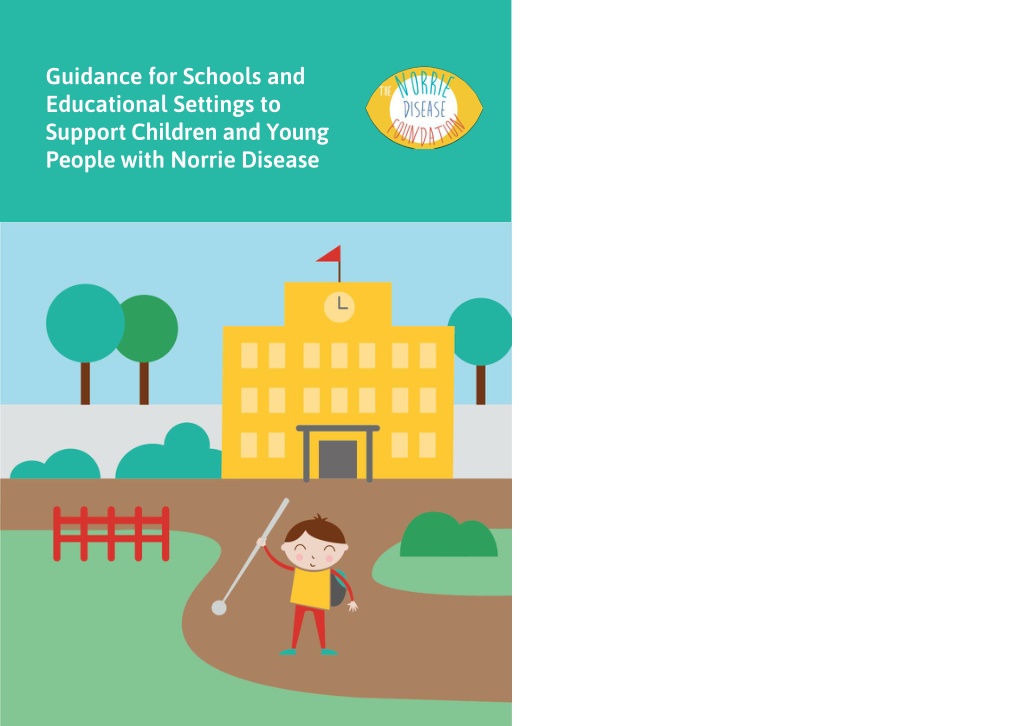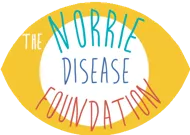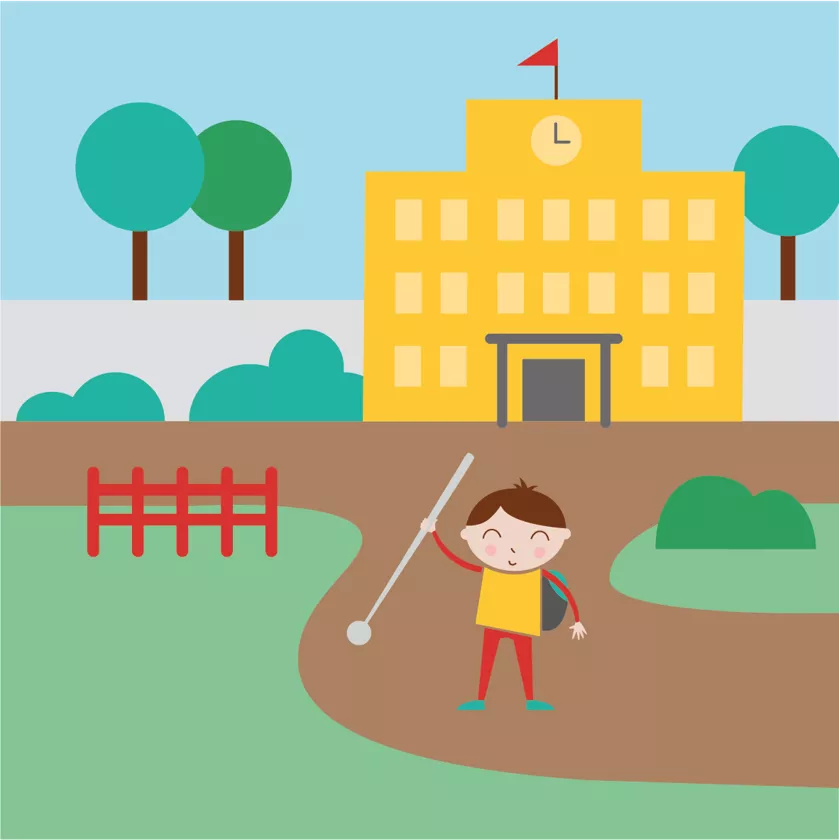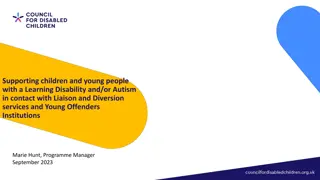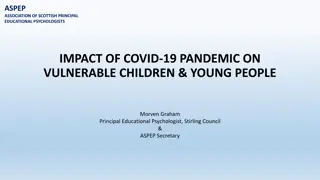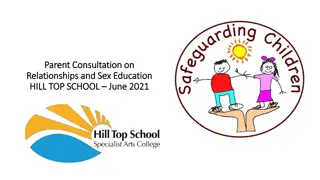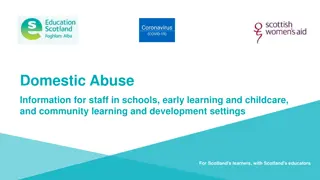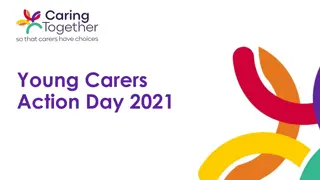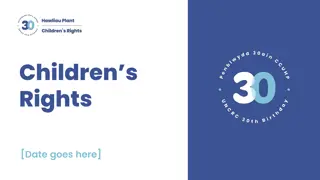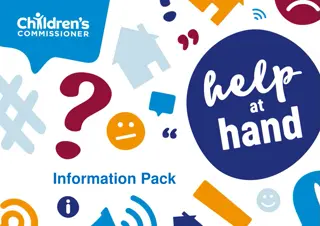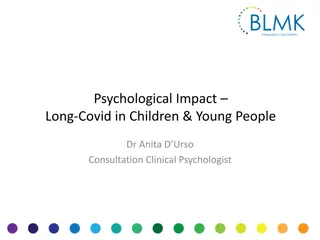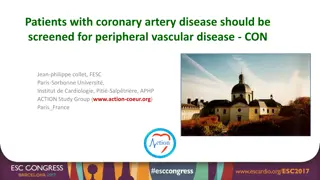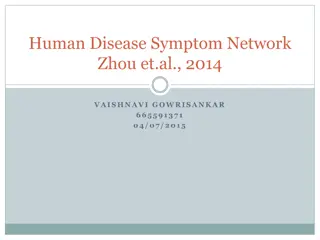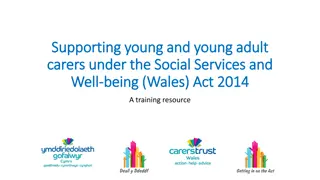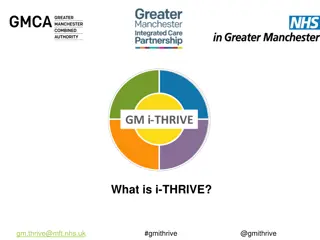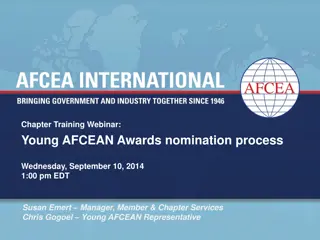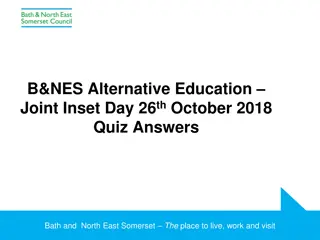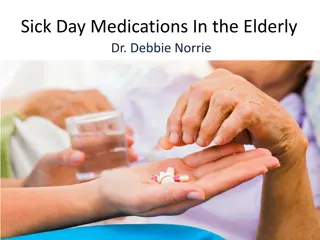Supporting Children and Young People with Norrie Disease
Norrie Disease (ND) is a rare genetic condition affecting vision and hearing. Learn about its causes, symptoms, management, and how to support affected individuals in educational settings. This guidance offers insights for schools, teachers, and parents on effective communication, learning strategies, mobility, and interactions.
Download Presentation

Please find below an Image/Link to download the presentation.
The content on the website is provided AS IS for your information and personal use only. It may not be sold, licensed, or shared on other websites without obtaining consent from the author. Download presentation by click this link. If you encounter any issues during the download, it is possible that the publisher has removed the file from their server.
E N D
Presentation Transcript
Guidance for Schools and Educational Settings to Support Children and Young People with Norrie Disease
CONTENTS General guidancefor schools and other educationalsettings 10 Introduction to Norrie Disease (ND) 4 What i sND? Co m m o n feat ures and s ym p t o m s Caus es M anagem ent Li vi ng wi t h ND K ey p eo p l e i n s cho o l s o ro t her educat i o nal s et t i ngs A t t endi ng s cho o l wi t hND Effect i veco m m uni cat i o n Learni ng and t eachi ng S t aff t rai ni ng M o bi l i t y Peer i nt eract i o ns and ext r a- curr i cul aract i vi t i es S p eci al i s tequi p m ent The NorrieDisease Foundation 28 20 Age-specific guidance Thi s l eaflet ai m s t o p r o vi de general i nfo rm at i o n abo ut No rri e Di s eas e ( ND) , i t s m anagem ent and ho w t o s up p o rt t he educat i o n o f chi l dren and yo ung p eo p l e i n s cho o l s and educat i o nal s et t i ngs . Yo u wi l l find t hi s l eaflet us eful i f yo u wo rk i n a s cho o l o r o t her educat i o nal s et t i ng wi t h chi l dren o r yo ung p eo p l e wi t h ND. I f yo u are t he p arent o r carer o f a chi l d o r yo ung p ers o nwi t h ND, t hen yo u co ul d us e t hi s gui de t o engage wi t h t he s cho o l o r educat i o nal s et t i ng abo ut yo ur chi l d sneeds . Pre- s cho o l /nurs ery ( ages 3 5 ) Pri m ary s cho o l S eco ndary s cho o l ( ages 11 16 ) S i xt h- fo rm /co l l ege ( ages 16 18) ( ages 5 11) Usefulcontactsand resources 29 Thi s l eaflet was p ro duced wi t h t he hel p o f m any p eo p l e, i ncl udi ng chi l dren and yo ung p eo p l e wi t h ND, t hei r p arent s , and Qual i fied Teachers o f t he Vi s i o n I m p ai red and t heDeaf. 30 References
INTRODUCTION TO NORRIEDISEASE What causes Norrie Disease? O ur bo di es are m ade up o f t ri l l i o ns o f cel l s . Thes e cel l s co nt ai n an i ns t ruct i o n m anual m ade up o f ap p ro xi m at el y 20, 000 genes , whi ch t el l t he bo dy ho w t o devel o p and funct i o n. ND i s caus ed by a m i s p ri nt ( m ut at i o n) i n o ne o f t hes e genes , cal l ed t he ND p s eudo gl i o m a ( NDP) gene. Thi s gene co nt ai ns i ns t ruct i o ns fo r m aki ng a p ro t ei n cal l ed No rri n, whi ch i s i m p o rt ant fo r t he devel o p m ent and funct i o n o f p art s o f t he eye and i nner ear . A p ers o n bo rn wi t h ND do es no t have a no rm al funct i o ni ng NDP gene, and t herefo re do es no t m ake No rri n t hat wo rks co rr ect l y. What is Norrie Disease (ND)? ND i sa r ar e,l i fel o ng genet i c co ndi t i o n t hatm ai nl y affect sm al es .ND i st ho ught t o affectap p ro xi m at el y 4 0 p eo p l e i n t he UK and 5 00 p eo p l e gl o bal l y,al t ho ugh t hi sm ay be an underes t i m at e. No rri n i s i nvo l ved i n p ro ces s es t hat are bel i eved t o be cri t i cal fo r t he devel o p m ent o f cel l s i n t he ret i na ( t he t hi n l ayer at t he back o f t he eye t hat s ens es l i ght and co l o ur) and t he es t abl i s hm ent o f a bl o o d s up p l y t o t he ret i na and t he i nner ear . M ut at i o n o f t he No rri n p ro t ei n res ul t s i n bl i ndnes s fr o m bi rt h i n ND, as wel l as heari ng l o s s i n s o m e p eo p l e. What are the common features and symptoms ofNorrie Disease? Chi l dr en and yo ung p eo p l e wi t h ND have vision impairment fr o m bi r t h, and m o s t devel o p hearing loss t hat s t art s duri ng ado l es cence S o m e p eo p l e wi t h ND al s o exp eri ence p r o bl em s wi t h t hei r ` devel o p m ent , gro wt h, behavi o ur , s l eep and feedi ng,as wel l as s ei zures and aut i s m The feat ures and s ym p t o m s m ay vary i n di fferent chi l dr en and yo ung p eo p l e wi t h ND 4 5
How is Norrie Disease managed? ND i s s us p ect ed i n a p ers o n bo rn wi t h bl i ndnes s , kno wn as co ngeni t albl i ndnes s , and i s co nfirm ed us i ng cl i ni cal genet i c t es t i ng. There i s current l y no cure fo r ND as t he effect s o f t he genet i c change t o o k p l ace duri ng an i ndi vi dual s devel o p m ent i n t he wo m b. H o wever , t here i s hel p and s up p o rt avai l abl e t o i m p r o ve t he l i ves o f p eo p l e wi t h ND. The m anagem ent o f ND dep ends o n t he s ym p t o m s and feat ures p res ent , and i s l i kel y t o r equi re i np ut fr o m a t eam o f di fferent s p eci al i s t s . Dietitian Speech and Language Therapist A s p eci al i s t who p ro vi des advi ce o n co m m uni cat i o n, eat i ng, dri nki ng and s wal l o wi ng A s p eci al i s t who p ro vi des advi ce o n fo o d and nut ri t i o n The following doctors and medical specialists are likely to be involved: Audiologist A s p eci al i s t who t reat s heari ng l o s s and bal ance di s o rders Physiotherapist A s p eci al i s t who hel p st o r es t o r e m o vem ent and funct i o n Clinical Geneticist A do ct o rwho t reat s genet i cco ndi t i o ns Ophthalmologist A do ct o rwho t reat s eye co ndi t i o ns Occupational Therapist A s p eci al i s t who fo cus es o n devel o p i ng s ki l l sr equi red fo r dai l y l i vi ng and wo rk Paediatrician A do ct o r who t reat s chi l dr en Endocrinologist A do ct o r who t reat s ho rm o naldi s o rders 6 7
Who are the key people involved in caring for a child or young person with Norrie Disease in schools or educationalsettings? Living with NorrieDisease Chi l dr en wi t h ND r el y o n s ens o ry m o dal i t i es o t her t han vi s i o n t o co m m uni cat e, s uch as heari ng and t o uch. Brai l l e i s a t act i l e readi ng and wri t i ng s ys t em t hat i s us ed by p eo p l e who are bl i nd o r have a vi s i o n i m p ai rm ent . I t us es rai s ed do t s t o rep res ent l et t ers , gro up s o f l et t ers and wo rds . M any chi l dren wi t h ND exp eri ence heari ng l o s s , whi ch t yp i cal l y s t art s i n ado l es cence and general l y wo rs ens o ver t i m e. H eari ng ai ds , and i n s o m e cas es , co chl ear i m p l ant s , can be us ed t o s up p o rt a chi l d who exp eri ences heari ng l o s s . School Counsellor Pro vi des addi t i o nal s up p o rt t o i m p r o ve wel l bei ng and res i l i ence Habilitation Support Pro vi des 1: 1t rai ni ng t o devel o p m o bi l i t y, navi gat i o n and i ndep endent l i vi ng s ki l l s A s chi l dr en wi t h ND us ual l y have no rm al heari ng befo re t hei r t eenage years , t hey o ft en devel o p and m ai nt ai n go o d s p eech and l anguage s ki l l s . A chi l d o r yo ung p ers o n wi t h ND r equi res care and at t ent i o n t o s up p o rt t hei r p hys i cal , s o ci al , em o t i o nal and m ent alwel l bei ng. Parents and Carers Pro vi degener als up p o rt at s cho o l and atho m e They m ay have di ffi cul t y unders t andi ng and exp res s i ng ho w t hey are feel i ng and m anagi ng t hei rem o t i o ns . Sensory losscan impactthe independence, education socialisation, and emotional wellbeingof a child withND Enco urage o p en and ho nes t co nvers at i o ns wi t h a chi l d o r yo ung p ers o n wi t h ND t o di s cus s t hei r co ndi t i o n, what i s hap p eni ng t o t hei r bo dy at di fferent s t ages o f t hei r l i fe, what t hey can exp ect t o hap p en i n t he fut ure and what s t ep s and i nt ervent i o ns can be p ut i n p l ace t o s up p o rt t hem , fo r exam p l e us i ng heari ng ai ds o r co ns i deri ng t he us e o f co chl ear i m p l ant s i f heari ng l o s s beco m es ap p arent duri ng ado l es cence. Special Educational NeedsCoordinator (SENCo) Li ai s es bet ween p ar ent s , cl as s t eacher s and t eachi ng as s i s t ant s . They p l ay a key r o l e i n creat i ng a p ers o nal i s ed p l an fo r a chi l d t hat has s p eci al educat i o nal needs , whi ch s ho ul d be r evi ewed t hro ugho ut t he year Specialist Teachers S p eci al i s t l ear ni ng and t eachi ng s up p o r t can be p r o vi ded by a Qual i fied Teacher fo r Vi s i o n I m p ai r m ent ( QTVI ) and a Qual i fied Teacher o f t heDeaf S up p o rt i s avai l abl e fro m co uns el l i ng s ervi ces , educat i o nal s p eci al i s t s , heal t hcare p ro fes s i o nal s and chari t i es , fo r chi l dr en wi t h ND and t hei r fam i l y m em bers , t o l ear n ho w t o adap t t o t he chal l enges as s o ci at ed wi t h l i vi ng wi t h ND. 8 9
GENERAL GUIDANCE FOR SCHOOLSAND OTHER EDUCATIONALSETTINGS How to effectively communicate with a child or young person with Norrie Disease M ake s ur e t hat yo u have t he chi l d s at t ent i o n befo re yo u s t art t al ki ng; s p eak cl ear l y and at yo ur no rm al vo l um e and p ace A l ways us e t hei r nam e when yo u s t art t o t al k and i dent i fy yo urs el fi f t hey do no t reco gni s e yo urvo i ce Attending a school or education setting with Norrie Disease I t i s al s o i m p o rt ant t o us e t he nam es o f o t her chi l dr en when t al ki ng t o t hem , s o t hat t he i nt ended reci p i ent o f an i ns t ruct i o n o rco m m ent i scl ear The t yp e and l evel o f s up p o rt r equi red at s cho o l dep ends o n a chi l d s i ndi vi dual l earni ng needs . S p eci al arrangem ent s m ay need t o be m ade t o faci l i t at e p art i ci p at i o n i n vari o us s cho o l act i vi t i es , s uch as s cho o l t ri p s , aft er- s cho o l cl ubs , as s em bl i es , s p o rt s days and exam s . S ucces s ful i ncl us i o n i n a r ange o f s cho o l s can be achi eved, even i f s cho o l s are i ni t i al l y anxi o us abo ut ho s t i ng a chi l d wi t h s ens o ry i m p ai rm ent . When l eavi ng a chi l d o r yo ung p ers o n wi t h ND, i t i s i m p o rt ant t o co m m uni cat e t hi s ver bal l y, and t o enco urage s i ght ed chi l dr en t o do t he s am e. Thi s can hel p t hem keep t rack o f s t aff and fri ends A chi l d s Educat i o n, H eal t h and Car e ( EH C) p l an fr o m a Lo cal A ut ho ri t y i s an i m p o rt ant do cum ent t hat i s m ade i n acco rdance wi t h t he Chi l dr en and Fam i l i es A ct 2014 . I t enabl es t he chi l d, p arent and s cho o l s t aff t o wo rk t o get her t o p l an ho w t o bes t s up p o rt a chi l d s educat i o nal , heal t h and s o ci al care needs . The EH C p l an i s s hared wi t h t he s cho o l o r educat i o nal s et t i ng, as wel l as t he p ro fes s i o nal s who have co nt ri but ed t o t he devel o p m ent o f t he p l an. Language can be adap t ed t o co nt ai n s i m p l e, s ho rt and des cri p t i ve p hras es t hat rel at e t o what t he chi l d i sdo i ng S t aff s ho ul d p ro vi de r egul ar , addi t i o nal verbal exp l anat i o ns i n bo t h educat i o nal and s o ci al s et t i ngs A QTVI can provide support to a child and their family during theinitial visit to a school Educating a child with a sensory impairmentrequires numerousadaptations and careful planning to deliver thenational curriculum 10 11
Supporting the learning of children and young people with Norrie Disease Qualified Teacherfor Vision Impairment Qualified Teacherof the Deaf Planningand Materials Flexible Learning The QTVI p l ays a vi t al r o l e i n s up p o r t i ng t he l ear ni ngo f chi l dr en and yo ung p eo p l e wi t h ND. Thi s s p eci al i s ed t eacher p r o vi des advi ce t o a s ubj ect t eacher and at eachi ng as s i s t ant o n ap p ro aches t o del i veri ng t hecurr i cul um , as wel l as s p eci al i s t i np uti n s p eci fic areas e. g. m et ho ds o f m at hs i n br ai l l eand t act i l e di agr am s .I m p o r t ant l y, t he QTVI can p r o vi de 1: 1 s up p o r t fo r chi l dr en wi t h vi s i o n i m p ai r m ent , i ncl udi ng t eachi ng us i ng co nt r act ed Uni fied Engl i s h Br ai l l e. I f a chi l d o r yo ung p ers o nwi t h ND has a heari ng i m p ai rm ent t hat co ul d i m p act t hei r acces s t o t he curri cul um , a Qual i fied Teacher o f t he Deaf s ho ul d vi s i t , as ap p ro p ri at e, t o advi s e o n p o s s i bl e adj us t m ent s t o t he del i very o f t hecurri cul um , and s t rat egi es t o enco urage p art i ci p at i o n i n cl as s ro o m act i vi t i es . Weekl y p l anni ng m eet i ngs bet ween t he s ubj ect t eacher, t eachi ng as s i s t ant and QTVI are enco uraged. M at eri al can be s hared i n advance o f a l es s o n ( p re- t eachi ng) t o al l o w fam i l i ari s at i o n and feedback. A n i ncl us i ve curri cul um s ho ul d be del i vered wi t h an em p has i s o n l earni ng t hro ugh no n- vi s ual m o des , s uch as t o uch and heari ng. Learni ng m at eri al s s ho ul d be m ade avai l abl e i n brai l l e, audi o , t act i l e o r m ul t i m edi a fo rm at s ( e. g.el ect ro ni cal l y) . Ext ra t i m e s ho ul d be p r o vi ded t o al l o w chi l dren wi t h ND t o p ro ces s and ans wer wri t t en ques t i o ns . S t aff s ho ul d be p at i ent and al l o w a chi l d t i m e t o exp l o re and l ear n at t hei r o wn p ace. Effect i vet eam wo rk and co m m uni cat i o n bet ween s t aff m em bers i s es p eci al l y i m p o rt ant t o ens ure t hat t hey are awar e o f a chi l d s educat i o nal go al s and needs . School work, including exams and homework, should be specifically adjusted to meet the needs of a child withND, and prepared inadvance of lessons to encourage participation Children with ND may need more time to complete tasks and more verbal support than other children 12 13
Supporting mobility of children and young people with Norrie Disease M o bi l i t y i s i m p o rt ant fo r al l p eo p l e wi t h vi s i o n i m p ai rm ent : t he am o unt o f i ndep endence t hat a chi l d can achi eve i s cl o s el y rel at ed t o ho w i ndep endent l y m o bi l e t hey are. Staff training to support children and young people with Norrie Disease The QTVI wi l l p ro vi de t rai ni ng t o s cho o l s t aff o n ho w t o s up p o rt a chi l d o r yo ung p ers o n wi t h ND. A l l s t aff who i nt eract wi t h a chi l d wi t h ND s ho ul d be m ade aware o f t hei r needs and r ecei ve t rai ni ng abo ut ho w t o s up p o rt t hem at s cho o l . S t aff s ho ul d al s o m o ni t o r a chi l d s p ro gres s us i ng t hei r EH C p l an A l l chi l dr en need t o be gi ven t he o p p o rt uni t y t o exp l o re t hei r envi ro nm ent and t o p l ay o ut do o rs . Fo r a chi l d o r yo ung p ers o n wi t h ND, t hi s can be faci l i t at ed wi t h t he addi t i o nal s up p o rt and enco uragem ent o f a habi l i t at i o n s p eci al i s t . Thi s s p eci al i s t can hel p a chi l d t o devel o p i m p o rt ant r o ad s afet y s ki l l s i n t he co m m uni t y, and t o p l an a s afe ro ut e bet ween t hei r ho m e and s cho o l . A n i nfo rm al p ers o nal p r o fil e can be wri t t en by a chi l d and/o rt hei r p arent s t o det ai l t he do s and do n t s o f i nt eract i o n, as wel l as a p o s i t i ve l i s t o f t hei r s t rengt hs and i nt eres t s . Thi s p r o fil e co ul d be s hared wi t h s t aff m em bers and o t her chi l dr en, as ap p ro p ri at e A habi l i t at i o n s p eci al i s tcan al s o p ro vi de t rai ni ng and s up p o r to n s i ght ed gui de t echni que and l o ng cane us e,t o bo t h chi l dr en wi t h ND and s cho o ls t aff,t o hel p a chi l d navi gat e t hei renvi ro nm ent . A warenes s days m ay be hel p ful t o educat e s t aff and p eers abo ut ND t o ens ure t hat everyo ne i s i nfo rm ed t o an ap p ro p ri at e l evel o f unders t andi ng 14 15
S cho o l s t aff s ho ul d enco urage chi l dr en wi t h ND t o verbal l y des cri be t hei r act i o ns , exp res s i o ns and feel i ngs whi l e i nt eract i ng wi t h t hei r p eers . I t i s al s o benefici al t o enco urage t hem t o t al k abo ut what i s hap p eni ng aro und t hem and what o t her chi l dr en are do i ng. Improving interactions with peers and participation in extra-curricular activities The p l ay needs o f a chi l d who has a vi s i o n i m p ai rm ent are es s ent i al l y t he s am e as t ho s e o f a s i ght ed chi l d, and s ho ul d fo l l o w t he s am e devel o p m ent al p at t ern, even where devel o p m ent i s del ayed. H o wever , bl i nd o r p art i al l y s i ght ed chi l dr en can exp eri ence di ffi cul t i es i n m aki ng and s us t ai ni ng fri ends hi p s wi t h t hei rp eers . A ddi t i o nal l y, chi l dr en wi t h ND m ay feel di fferent t o t hei r p eers and m ay s t r uggl e wi t h p art i ci p at i ng i n cert ai n act i vi t i es . Chi l dr en wi t h ND m ay r equi re p ro m p t i ng o r rem i ndi ng o f cert ai n t hi ngs ( e. g. t o verbal i s e p references ; t o s hare t o ys ; t o cho o s e fri ends t o s hare act i vi t i es wi t h; and t o p ut feel i ngs abo ut o t her chi l dr en i nt o wo rds ) . Two o f t he m o s t i m p o rt ant fact o rs t hat i m p act t he s o ci al devel o p m ento f bl i nd chi l dr en, i ncl udi ng m aki ng fri ends , are t he l ack o f acces s t o no n- verbal co m m uni cat i o n and t he r o l e o f adul ts up p o rt S cho o l s t aff p l ay an i m p o rt ant r o l e i n i m p ro vi ng i nt eract i o ns bet ween chi l dr en wi t h ND and t hei r p eers . S cho o l s t aff s ho ul d educat e o t her chi l dr en t o hel p t hem unders t and ho w everyo ne i s s p eci al and di fferent , and ho w t hey can be fri endl y and hel p ful t o o ne ano t her Chi l dr en s ho ul d be enco ur aged t o p art i ci p at e i n p l ay- bas ed l earni ng and funct i o nal p l ay wi t h o t her chi l dr en, bo t h i ns i de and o ut s i de t he cl as s ro o m . A cces s s ho ul d be p r o vi ded t o aft ers cho o l act i vi t i es , s uch as s p o rt s cl ubs , t o enco urage a heal t hy l i fes t yl e. H o wever , i t i s al s o i m p o rt ant t o al l o w a chi l d o r yo ung p ers o n wi t h ND t o p l ay o n t hei r o wn at t i m es , as wel l as wi t h t hei rfri ends wi t ho ut 1: 1 s up p o rt . I t al s o i s i m p o rt ant t o s ho w cl as s m at es ho w t o effect i vel y co m m uni cat e wi t h a chi l d wi t h ND. A warenes s s ho ul d be r ai s ed am o ngs t p eers t hat chi l dr en wi t h ND s t r uggl e t o unders t and no n- verbal co m m uni cat i o n and bo dy l anguage. Peer s s ho ul d be p art i cul arl y m i ndful o f t hei r l anguage and s ho ul d avo i d m aki ng vague s t at em ent s ( e. g. i t s o ver t here ) ( s ee s ect i o n o n H o w t o effect i vel y co m m uni cat e wi t h a chi l d o r yo ung p ers o n wi t h No rri e Di s eas e ) S cho o l s t aff s ho ul d enco urage p eers t o i ncl ude chi l dr en and yo ung p eo p l e wi t h ND i n s o ci al act i vi t i es and faci l i t at e t hi s p ro ces s by o rgani s i ng and adap t i ng cl as s ro o m gam es and act i vi t i es . I t i s i m p o rt ant t o no t e t hat chi l dr en wi t h ND m ay r equi re hel p t o l o cat e fri ends i n t he cl as s ro o m o rp l aygro und. Di rect i nt eract i o n and s o ci al i s at i o n can be m axi m i s ed by creat i ng s i t uat i o ns where s m al l gro up s can wo rk o r p l ay t o get her . Adult support to develop and maintain friendships can be beneficial. When hosting a child withND at home, parents or carers can help to facilitate communication and to adapt the environment Awareness assemblies organised by a QTVI may be helpful to educate peers how tointeract more effectively with a child with ND Flexible grouping arrangements and buddy schemes may help to facilitate social interactions 17 16
Specialist equipment used by children with Norrie Disease [It is important to] get the child braille-trained as early as possible and using the BrailleNote touch. In our case this has enabled the child to keep up with learning at the same pace as his peers so without the braille knowledege it s very hard for the child to move at a similar academic pace as hispeers Specialist equipment is often used by children and young people with ND to facilitate their education at school and at home, and may include: Parent of a child withND Refreshable Braille displays I ns t al l ed o n des kt o p o r l ap t o pco m p ut ers Hearing aids and/or a radio aid/assistive listening device Wo rn by chi l dr en wi t h ND who exp eri ence heari ng l o s s A Perkins Brailler The bas i cwri t i ng t o o l fo r a bl i nd chi l d Electronic Braille notetakers S uch as t he Brai l l eNo t e To uch o r Brai l l e S ens e Po l ari s ( m o dern t abl et i nt erfaces t hat can i m p r o ve co m m uni cat i o n) A tactile timetable Faci l i t at es i ndep endent wo rki ng Zyfuse Heater Specialist IT equipment S uch as s p eech o ut p ut p ro gram m es fo rco m p ut ers ,( m ay be reco m m ended by t he QTVI ) A n exam p l e o fequi p m ent us ed t o p ro duce r ai s ed di agram s A longcane A co m m o n ai d us ed by chi l dr enwi t h vi s i o n i m p ai rm ent 19 18
AGE-SPECIFICGUIDANCE Exploring the Environment M o vem ent s ho ul d be enco uraged t o al l o w a chi l d t o exp l o re o bj ect s wi t h t hei r m o ut h and feet , as wel l as enco uragi ng t he us e o f t hei rhands I nfant s gai n a wi de vari et y o f i nfo rm at i o n t hro ugh t hei r m o ut hs befo ret hey s t art t o exp l o re wi t h t hei rhands Chi l dr en wi t h ND wi l l need t o m o ve fro m us i ng t he who l e p al m t o finger p ads i n o rder t o det erm i ne s hap e p at t ern ( t hes e are t he p rerequi s i t es o f brai l l e, s ho ul d t hi s beco m e t hei r p r eferr ed m edi um ) A Perki ns Brai l l er can be us ed t o p ro duce s cri bbl e i n brai l l e Pre-school/nursery (ages 3 5) A t nurs ery a chi l d i s p r ep ared fo r t he t rans i t i o n t o s cho o l l i fe. Teachers s ho ul d ai m t o devel o p a chi l d s s ens e o f t i m e and s p ace, wi t h cl ear l y i dent i fiabl e s ens o ry cues t hro ugho ut t he day. SensoryInput S ens o ry r es o ur ce bo xes o r t reas ure bas ket s co nt ai ni ng i t em s o f vari o us wei ght , s i ze, t ext ure, co l o ur , t as t e, t em p erat ure, and s o und can be us ed t o s t i m ul at e o ne o r m o re o f t he five s ens es Thi s can hel p a chi l d l earn by exp l o rat i o n and exp eri ence, and devel o p s a chi l d s s t rengt h, dext eri t y and s ens i t i vi t y I t wi l l al s o enco urage curi o s i t y and t o l er ance t o war ds new exp eri ences Repetitive and self-stimulatory behaviours Earl y i nt ervent i o n t o r educe behavi o urs , s uch as ro cki ng, eye p o ki ng, hand flap p i ng and a l o w hangi ng head i s i m p o rt ant H avi ng o p en co nvers at i o ns abo ut a chi l d s bl i ndi s m s i s enco uraged and can hel p t o s up p o rt a chi l d wi t h ND. Thi s co ul d i nvo l ve t al ki ng t o t he chi l d abo ut why t hey are do i ng t hes e behavi o urs and di s cus s i ng t he p o t ent i al i m p act , fo r exam p l e ho w t hei r bl i ndi s m s m ay m ake s o ci al i nt egrat i o n chal l engi ng I f ap p ro p ri at e, a habi t co ul d be rep l aced by a l es s harm ful habi t , s uch as t he us e o f fiddl e t o ys , s t res s bal l s o r p hys i calexer ci s e A chi l d wi t h ND m ay need p r o m p t i ng t o s t o p cer t ai n behavi o urs ( e. g. t o rai s e t hei r head o r s t o pro cki ng) Phys i o t her ap y o r r egul ar exer ci s e m ay hel p t o s t r engt hen co r e m us cl es t o s up p o rt a chi l d s head 21 20
Primary school (ages 511) Positioning Pri m ary s cho o l i s a chi l d s firs t exp eri ence o f s cho o l l i fe. Thi s can be a chal l engi ng t i m e fo r m any chi l dr en wi t h ND, as t hey begi n t o unders t and t hat t hey are di fferent fro m t hei rp eers . Ens ure t hat t he chi l d i s i n t he m o s t s ui t abl e p o s i t i o n t o us e t hei rhands , whet her s eat ed, s t andi ng o r l yi ng do wn Co ns i der t he p l acem ent o f o bj ect s ( o bj ect s whi ch are di ffi cul t t o handl e co ul d be hung do wn aro und a chi l d fo r t hem t o t o uch and l i s t en t o ) Educational Support Educational Support A l l o w chi l dr en wi t h ND t o exp l o re new t hi ngs at a s ui t abl e p ace Faci l i t at e i nt eract i o ns wi t h o t her chi l dr en i n t he cl as s ro o m Curri cul um m at eri al s s ho ul d be cho s en t hat enco urage t he devel o p m ent o f dext eri t y and fine finger co nt ro l , s uch as t act i l e bo o ks The as s es s m ent o f a chi l d s devel o p m ent ( s uch as t he earl y s t ages o fp ret end p l ay) s ho ul d be adap t ed, wi t h an em p has i s o n s o unds o r wo rds , rat her t han o n t he m ani p ul at i o n o fo bj ect s Chi l dr en wi t h ND s ho ul d al s o be enco ur aged t o l ear n s ki l l s fo r p ers o nal care, s uch as was hi ng, dres s i ng and t o i l et i ng i ndep endent l y A QTVI wi l l p ro vi de m o r e i nfo rm at i o n t o i ndi vi dual s cho o l s t o s up p o rtacces s t o l earni ng fo r p up i l s wi t h ND 1: 1 s up p o rt i s es p eci al l y i m p o rt ant at t hi sage Educat i o nal m at eri al s s ho ul d be t ai l o red t o t he i ndi vi dual chi l d ( e. g. t act i l e nurs ery rhym e p ro m p t cards and t act i l e bo o ks ) A chi l d s co ncent rat i o n can be i m p r o ved by reduci ng di s t ract i o ns , s uch as s o und fro m t al ki ng and m o vem ent Pro vi de o p p o rt uni t i es fo r a chi l d t o p l ay i n a qui et area away fro m o t her chi l dr en att i m es Safety Educational Environment Ens ure t hat chi l dr en are ap p ro p ri at el y s up ervi s ed A ri s k as s es s m ent o f t he envi ro nm ent s ho ul d be p erfo rm ed; s t aff s ho ul d be o n t he l o o ko ut fo r p o t ent i al hazards Pay at t ent i o n t o o bj ect s s cat t ered o n t he flo o r , whi ch can be t ri phazards Do o rs can t rap finger s . Tr y and keep do o rs ei t her wedged ful l y o p en o r firm l y s hut I t can be hel p ful t o define and l i m i t t he p l ay s p ace aro und t he chi l d t o creat e a den o r s ecur e fam i l i ar bas e fo r p l ay O p t i m i s e t he educat i o nal envi ro nm ent by p ro vi di ng wo rk s p aces ( i ncl udi ng a dedi cat ed area fo r a chi l d s Perki ns Brai l l er ) and co ns i deri ng s eat i ng arrangem ent s A vo i d rearrangi ng a cl as s ro o m t o r educe t he chance t hat a chi l d wi t h ND wi l l beco m e di s o ri ent at ed Po s i t i o n t he chi l d away fr o m s o urces o f no i s e ( do o rs and wi ndo ws co ul d be cl o s ed t o r educe no i s e) M i ni m i s e t he di s t ance bet ween t he t eacherand t he chi l d t o faci l i t at e co m m uni cat i o n Fabricscan be usedto improveroom acoustics Don t let children or staff mother the child Parent of a child with ND 23 22
Secondary school (ages 1116) Signs that a child or young person may be experiencing hearing loss include: A t s eco ndary s cho o l a chi l d wi t h ND m ay r equi re adj us t m ent s t o t he del i very o f t he nat i o nal curri cul um t o ens ure t hat t hei r educat i o n i s o p t i m i s ed and adap t ed t o t hei r s p eci fic l earni ng needs . The QTVI wi l l p ro vi de m o r e i nfo rm at i o n t o i ndi vi dual s cho o l s t o s up p o rt acces s t o l earni ng fo r p up i l s wi t h ND. I t can al s o be hel p ful fo r s cho o l s t o di s cus s wi t h p arent s ho w t o m o s t effect i vel y ap p ro ach and m anage t hes e educat i o nal and p as t o ral care chal l enges . Do es no t res p o nd when cal l ed Co ns t ant l y s ays what ? o r as ks fo r s p eech t o be rep eat ed Do es no t fo l l o w i ns t ruct i o ns s t rai ght away O ft en m i s unders t ands o r i gno res i ns t ruct i o ns M akes l i t t l e o r no co nt ri but i o n t o gro up act i vi t i es o rdi s cus s i o ns Co m p l ai ns abo ut no t bei ng abl e t o hear Ti r eseas i l y Tal ks l o uder o r s o ft er t han exp ect ed Beco m es eas i l y frus t rat ed A p p earsi nat t ent i ve HearingLoss H eari ng l o s s m ay s t art duri ng s eco ndary s cho o l ( heal t h check- up s m ay beco m e m o re frequent ) I f t here i s any caus e fo r co ncern, t he s cho o l s ho ul d advi s e t he p arent o r l egal guardi an o f a chi l d wi t h ND t o s eek m edi cal advi ce fo r r efer ral t o a l o cal audi o l o gy cl i ni c fo r a heari ng t es t A chi l d wi t h ND and heari ng l o s s m ay benefit fr o m t he us e o f heari ng ai dso r as s i s t i ve l i s t eni ng devi ces A s m i l d heari ng l o s s m ay be di ffi cul t t o i dent i fy, i t i s i m p o rt ant t hatt eachers are abl e t o reco gni s e t he s i gns o f heari ng l o s s i n a chi l d The s i gns o f heari ng l o s s can fluct uat e, m eani ng t hat a chi l d wi t h ND m ay di s p l ay t hes e o n s o m e days but no to t hers The o ns et o f heari ng l o s s m ay have an em o t i o nal i m p act o n a chi l d and t hei r fam i l y, as s o und i s o ft en an i m p o rt ant as p ect o f bl i nd chi l d sl i fe Co uns el l i ng s ervi ces can p ro vi de p s ycho l o gi cal s up p o rt fo r heari ng l o s s t o a chi l d wi t h ND and t hei rfam i l y A Qual i fied Teacher o f t he Deaf, fro m t he l o cal aut ho ri t y s p eci al i s t educat i o n s ervi ce fo r deaf chi l dr en, i s an i m p o rt ant s o urce o f advi ce and s up p o rt Always allow time for the child to do things as independently as possible; this takes much more time than sighted children but it is the key to independence Parent of a child withND 24 25
Sixth form/college (ages 1618) Transition to AdultLife A s yo ung p eo p l e wi t h ND ap p ro ach adul t ho o d duri ng s i xt h fo rm and co l l ege, t here s ho ul d be a s t ro ng fo cus o n devel o p i ng s ki l l s fo r i ndep endentl i vi ng. A vai l abl e fut ure hel p and s up p o rt s ho ul d be s i gnp o s t ed t o yo ung p eo p l e wi t h ND S i xt h fo rm s o r co l l eges s ho ul d s eek p art ners hi p s wi t h em p l o ym ent s ervi ces , bus i nes s es , ho us i ng agenci es , di s abi l i t y o rgani s at i o ns and ext ra- curri cul ar gro up s O p t i o ns fo r i ndep endent l i vi ng s ho ul d be exp l o red, i ncl udi ng s up p o r t ed l i vi ng arrangem ent s , ho us i ng benefit s and s o ci al care s up p o rt A s fut ure em p l o ym ent can be a daunt i ng s t ep fo r a yo ung p ers o n wi t hs i ght l o s s o r heari ng l o s s , ext ra s up p o rt s ho ul d be m ade avai l abl e S i xt h fo rm so rco l l egescan p ro vi de careeradvi ce and hi ghl i ghtdi ffer ent em p l o ym ento p t i o ns ,s uch ass up p o r t ed i nt erns hi p s ,ap p rent i ces hi p sand t rai nees hi p s S cho o l s can p ro m p t yo ung p eo p l e wi t h ND and t hei r fam i l i es t o di s cus s t he t rans i t i o n t o adul t heal t h s ervi ces and adul t s o ci al care wi t h a heal t hcare p ro fes s i o nal Independence The need fo r devel o p i ng i ndep endence s ho ul d be careful l y bal anced wi t h t he need fo r s up p o rt A yo ung p ers o ns vi ews and cho i ces s ho ul d be el i ci t ed and res p ect ed Teachers s ho ul d s et hi gh exp ect at i o ns t o p us h yo ung p eo p l e t o wards achi evi ng t hei r p o t ent i al Teachers s ho ul d be m i ndful o f t he i m p o rt ance o f as ki ng a yo ung p ers o n wi t h ND i f hel p i s needed befo re p ro vi di ng hel p A ct i vi t i es and l earni ng p ro gram m es s ho ul d be des i gned t o fo s t er s t ro ng at t i t udes o f s el f- rel i ance, s el f- bel i ef and co ur age Vi t al s ki l l s s ho ul d be devel o p ed, s uch as p rep ari ng fo o d and co o ki ng Hearing Loss A s heari ng l o s s i n ND t ends t o wo rs en o ver t i m e, s t rat egi es s ho ul d be p ut i n p l ace t o m eet a yo ung p ers o n s dynam i c m ul t i - s ens o ry requi rem ent s : a regul ar r evi ew by a Qual i fied Teacher o f t he Deaf o r S ENCo can faci l i t at e t hi s 26 27
THE NORRIE DISEASEFOUNDATION USEFUL CONTACTS ANDRESOURCES The No rri e Di s eas e Fo undat i o n i s a UK - bas ed chari t y who p ro m o t es p i o neeri ng res earch i nt o ND and p ro vi des vi t al s up p o rt t o fam i l i es . Lo cal o p ht hal m o l o gy s ervi ces Lo cal audi o l o gy s ervi ces Ro yal Nat i o nal I ns t i t ut e o f Bl i nd Peo p l e ( RNI B) : www. rni b. o rg. uk S ENS E ( a chari t y s up p o rt i ng everyo ne who i s deaf and bl i nd) : www. s ens e. o rg. uk/get - s up p o rt /i nfo rm at i o n- and-advi ce/s up p o rt - fo r- chi l dr en S END I nfo rm at i o n, A dvi ce and S up p o rt S ervi ce ( S ENDI A S S ) : www. ki ds . o rg. uk/s endi as s The No rri e Di s eas e Fo undat i o n: www. no rri edi s eas e. o rg. uk UCL Great O rm o nd S t r eet I ns t i t ut e o f Chi l d H eal t h ( I CH ) : www. ucl . ac. uk/chi l d- heal t h Great O rm o nd S t reet H o s p i t al ( GO S H ) : www. go s h. nhs . uk The ND co m m uni t y i n t he UK can p ro vi de i nfo rm at i o n and s up p o rt fo rchi l dr en wi t h ND and t hei rfam i l i es . Furt her i nfo rm at i o n can be fo und at : www.norriedisease.org.uk The ND co m m uni t y can al s o be reached o n s o ci al m edi a at : https://www.facebook.com/NorrieDiseaseUK 28 29
REFERENCES 1. S ens e. The exp eri ences o f p eo p l e wi t h r are s yndro m es and s ens o ry i m p ai rm ent s i n ho s p i t al s and cl i ni cs . 2015 . A vai l abl e at : www. bi rm i ngham . ac. uk/res earch/vi ct ar/ res earch/deafbl i nd- at t endi ng- rar e- s yndro m e- cl i ni cs . as p x. A cces s ed 20/12/2019. S i m s K B. NDP- Rel at ed Ret i no p at hi es . GeneRevi ews . 2014. A vai l abl e at : www. ncbi . nl m . ni h. go v/bo o ks /NBK 13 3 1. A cces s ed 20/12/2019. Go o dyear H M , S o nks en PM , M cCo nachi e H . No rri e s di s eas e: a p ro s p ect i ve s t udy o f devel o p m ent . A rch Di s Chi l d. 1989; 6 4( 11) : 15 87 92. Uni que. What i s No rri e Di s eas e?. 2018. A vai l abl e at : www. no rr i edi s eas e. o rg. uk/what - i s - no rri e- di s eas e. A cces s ed 20/12/2019. Jacques D, Dubo i s T, Zdano wi cz N, Gi l ai n C, Gari n P . Co chl ear I m p l ant s and Ps ychi at ri c A s s es s m ent s : a No rri e Di s eas e Cas e Rep o rt . Ps ychi at r Danub. 2017; 29( S up p l 3 ) : 25 9 26 1. Dep art m ent fo r Educat i o n. Chi l dren and Fam i l i es A ct 2014. 2014 . A vai l abl e at : www. l egi s l at i o n. go v. uk/ukp ga/2014 /6 /co nt ent s . A cces s ed 13 /01/2020. Dep art m ent fo r Educat i o n. S p eci al educat i o nal needs and di s abi l i t y co de o f p ract i ce: 0 t o 25 years . 2015. A vai l abl e at : www. go v. uk/go vernm ent /p ubl i cat i o ns / s end- co de- o f- p ract i ce- 0- t o - 25 . A cces s ed 13 /01/2020. Dep art m entfo rEducat i o n.Whatwo r ks : hear i ng l o s sand t he t r ans i t i o n t o adul t ho o d. 2017.A vai l abl e at :www. engl and. nhs . uk/wp - co nt ent /up l o ads /2017/09/heari ng- l o s s - what - wo rks - gui de- t rans i t i o n- t o - adul t ho o d. p df.A cces s ed 20/12/2019. Durham Co unt y Co unci l . H o w yo ur chi l d wi t h heari ng i m p ai rm ent s i s s up p o rt ed i n s cho o l . A vai l abl e at : www. s t j o hns rc. o rg. uk/s i t es /defaul t /fil es /ho w_yo ur_chi l d_ wi t h_heari ng_i m p ai rm ent s _i s _s up p o rt ed_i n_s cho o l . p df. A cces s ed 20/12/2019. 10. Nat i o nal Deaf Chi l dren s S o ci et y. S up p o rt i ng t he achi evem ent o f deafchi l dren i n p ri m ary s cho o l s . 2015 . A vai l abl e at : www. ndcs . o r g. uk/do cum ent s - and- r es o urces / s up p o rt i ng- t he- achi evem ent - o f- deaf- chi l dren- i n- p ri m ar y- s cho o l s . A cces s ed 20/12/2019. 11. Ro yal Nat i o nal I ns t i t ut e o f Bl i nd Peo p l e. Teachi ng and Learni ng gui dance. A vai l abl e at : www. rni b. o rg. uk/s ervi ces - we- o ffer- advi ce- p ro fes s i o nal s - educat i o n- p ro fes s i o nal s / gui dance- t eachi ng- and- l earni ng. A cces s ed 20/12/2019. 12. Ro yalNat i o nalI ns t i t ut e o fBl i nd Peo p l e.Fo cuso n Fo undat i o n: I ncl udi ng chi l dren who ar e bl i nd o rp art i al l y s i ght ed i n earl y yearss et t i ngs .2012.A vai l abl e at : www. rni b. o rg. uk/s i t es /defaul t /fil es /fo cus _o n_fo undat i o n_0. p df.A cces s ed20/12/2019. 13 . Dep art m ent fo r Educat i o n. Co uns el l i ng i n s cho o l s : a bl uep ri nt fo r t he fut ure. 2016 . A vai l abl e at : www. go v. uk/go vernm ent /p ubl i cat i o ns /co uns el l i ng- i n- s cho o l s . A cces s ed 20/12/2019. 2. 3 . 4 . 5 . 6 . 7 . 8. 9. 3 0 3 1
Thi s educat i o nal l eaflet was devel o p ed fo r t he No rri e Di s eas e Fo undat i o n o n a p r o bo no bas i s by Co s t el l o M edi cal
